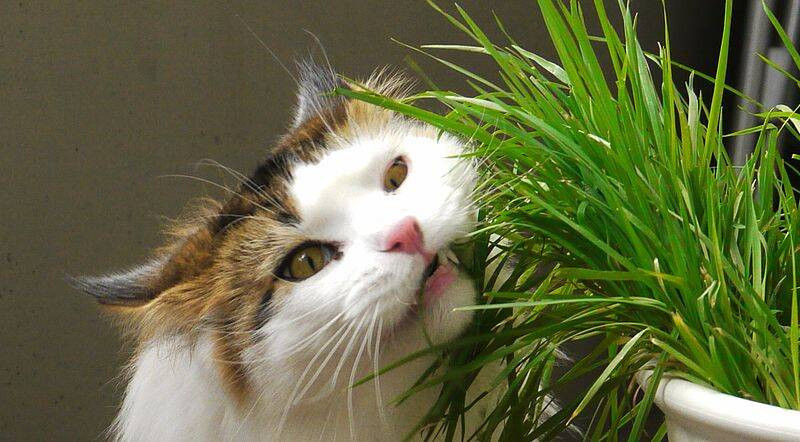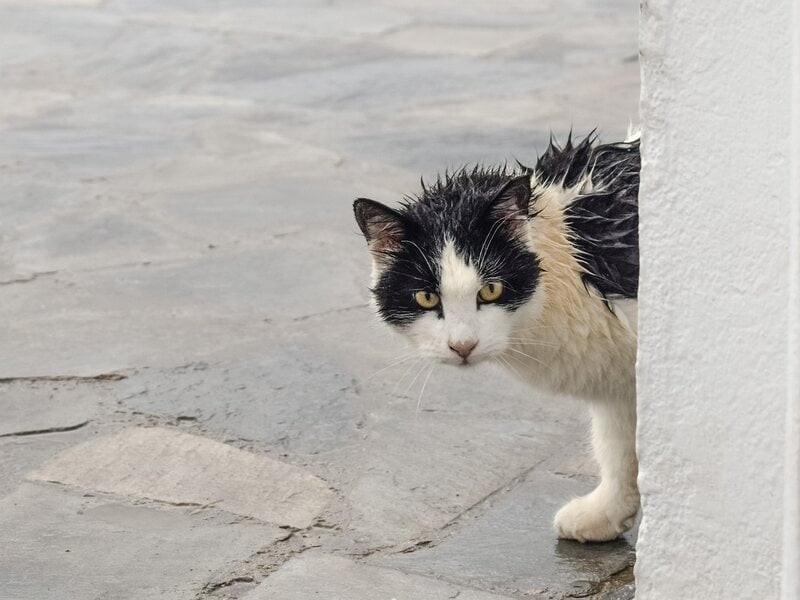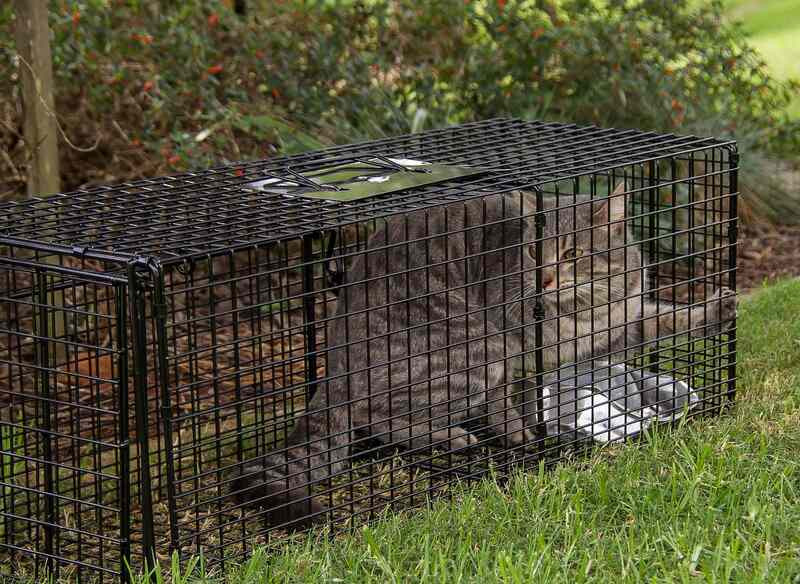Are you finding paw prints where they shouldn’t be? Perhaps neighborhood cats are turning your beloved garden into their personal playground or litter box. While many appreciate the occasional feline visitor, it’s understandable to want to keep cats out of your yard, especially if they’re causing damage or disturbing your pets. The good news is, you can deter cats humanely and effectively.
In this comprehensive guide, we’ll explore various strategies to help you reclaim your outdoor space without harming these furry creatures. From simple adjustments around your yard to slightly more involved methods, you’ll find a range of solutions to suit your situation and keep those unwanted feline guests at bay.
9 Humane Ways to Keep Cats Out of Your Yard and Garden
 A cat contentedly eating cat grass indoors
A cat contentedly eating cat grass indoors
Image: A domestic cat happily munching on cat grass inside a home, highlighting a safe and contained environment for felines.
If you’re tired of dealing with cats trespassing on your property, it’s crucial to address the issue with compassion. Forget about harmful traps or toxic substances. There are numerous humane and effective ways to discourage cats from entering your yard and garden, ensuring a peaceful coexistence without resorting to cruelty.
1. Eliminate Food Sources to Deter Cats
One of the primary reasons cats are attracted to your yard could be the availability of food. Unknowingly, you might be providing a buffet that draws them in. Just like raccoons rummaging through trash, cats might be scavenging for scraps or hunting birds and rodents on your property. Removing these food sources can significantly reduce their interest in your yard.
Ensure your trash cans are always tightly sealed. Consider using bungee cords to secure lids firmly, preventing resourceful felines from accessing discarded food. Never leave pet food outdoors, as this is an open invitation for neighborhood cats to help themselves. If you’re an avid bird lover and use bird feeders, temporarily discontinuing them might be necessary until you manage the cat situation. Bird feeders can inadvertently attract cats who prey on birds, thus making your yard a hunting ground.
2. Block Access to Cat Hideaways
Cats are naturally drawn to secure, sheltered spots where they can feel safe from predators and the elements. They often seek out dark, secluded areas like crawl spaces, the underside of decks, and similar undisturbed enclosures. These spaces provide perfect hiding spots for napping, observing, and feeling protected. By denying access to these hideaways, you make your yard less appealing to cats.
Install physical barriers like chicken wire or lattice to block entry to these under-deck and crawl space areas. Before sealing off any potential hiding places, carefully check to ensure no cats or kittens are already inside. Trapping an animal unintentionally can be harmful and distressing to the animal.
3. Utilize Scent Repellents to Keep Cats Away
Cats possess an incredibly sensitive sense of smell, far more acute than humans. Scents that are barely perceptible to us can be overwhelmingly strong and unpleasant to them. Certain aromas are naturally offensive to cats and can effectively deter them from entering specific areas.
Here are several scent-based cat repellents you can use in your yard and garden:
- Commercial Cat Repellent Sprays: Numerous commercially available sprays, such as PetSafe SSSCAT Spray and Nature’s Miracle Just for Cats Pet Block, are specifically formulated with scent combinations that cats dislike. These are designed for outdoor use and can be sprayed around the perimeter of your yard or in targeted areas.
- Citrus Peels: Cats generally dislike the smell of citrus. Scatter fresh citrus peels from oranges, lemons, grapefruits, or limes around your garden beds or areas you want to protect. You can also use citrus-scented sprays for a similar effect.
- Coffee Grounds: Used coffee grounds are another scent that many cats find unappealing. After brewing your morning coffee, spread the grounds around plants or in a perimeter to create a scent barrier.
- Tea Leaves: Similar to coffee grounds, used tea leaves can also act as a cat deterrent. Sprinkle used tea leaves or place used tea bags in areas you want to keep cat-free.
- Vinegar: The strong, pungent smell of vinegar is offensive to cats. Spray diluted white vinegar or apple cider vinegar (mix with water to avoid damaging plants) around your yard. Avoid spraying directly on grass or garden plants as vinegar can be harmful to vegetation.
- Pipe Tobacco: The strong aroma of pipe tobacco is disliked by many cats. Scatter pipe tobacco around the perimeter of areas you wish to protect.
- Essential Oils: Certain essential oils possess scents that cats find repellent. Mix a few drops (5-10) of lavender, citronella, lemongrass, or eucalyptus oil with water in a spray bottle. Spray this mixture around your yard or soak cotton balls or fabric strips in the oil and place them strategically.
- Blood Meal: Blood meal, a dried animal blood product, is another scent that cats dislike. Incorporate blood meal into your garden soil. As a bonus, it also acts as a fertilizer for your plants.
It’s important to note that the effectiveness of scent repellents can vary. Cats have individual preferences, and what repels one cat might not bother another. Experiment with different scents to determine which works best for the cats in your neighborhood.
Also, be aware that scents fade over time, especially outdoors. Reapply scent repellents regularly, approximately once a week, or after rain, to maintain their effectiveness.
Caution: Some of these substances can be harmful if ingested by cats. Exercise caution, especially if you know there are cats in your area prone to eating anything. In such cases, prioritize using alternative methods.
4. Plant Cat-Repelling Plants in Your Garden
 Close-up of vibrant purple lavender flowers in bloom
Close-up of vibrant purple lavender flowers in bloom
Image: Aromatic lavender plants with their characteristic purple blooms, showcasing a natural and fragrant cat deterrent for gardens.
Nature provides its own solutions for deterring cats. Certain plants emit scents that cats naturally dislike. Incorporating these plants into your garden can create a fragrant and visually appealing barrier that encourages cats to stay away. However, be mindful that some plants commonly recommended as cat repellents can be toxic to humans and pets if ingested or cause skin irritation upon contact.
Here are plants often suggested as cat repellents, but with important toxicity warnings:
- Pennyroyal: Highly toxic if ingested by both humans and pets.
- Rue: Can cause severe skin irritation in humans and pets.
- Scaredy-cat plant (Coleus canina): Causes skin and stomach irritation in pets.
- Lavender: Toxic to pets if ingested.
- Geraniums: Toxic to pets if ingested.
- Citronella: Toxic to pets if ingested.
- Lemongrass: Toxic to pets if ingested in large quantities, cats are more sensitive than dogs.
Safer, non-poisonous options for cat-repelling plants include rosemary, curry plant, and lemon thyme. These plants offer fragrant deterrence without posing significant toxicity risks to people or animals.
Similar to scent repellents, the effectiveness of cat-repelling plants can vary. What works for one cat might not deter another.
5. Make Lounging and Digging Spots Uncomfortable for Cats
Cats often develop favorite spots in yards for lounging in the sun or digging in soft soil, particularly in flower beds and vegetable gardens. By making these preferred areas less comfortable, you can discourage cats from using them.
Here are methods to cat-proof gardens and other lounging or digging areas:
- Plastic Carpet Runners (Spike Side Up): Place plastic carpet runners with the spike side facing upwards in garden beds, on car hoods (if cats lounge there), or any favored cat hangout spots. The plastic spikes are not harmful but are uncomfortable for cats to walk or lie on. Cover them with a thin layer of soil or mulch to make them less visible in gardens.
- CatScat Mats: These mats feature flexible, blunt plastic spikes that are unpleasant for cats to step on but won’t cause injury. Place CatScat mats in areas where cats frequently dig or lounge.
- Chicken Wire: Cover garden soil with chicken wire to prevent digging. Roll the sharp edges under to prevent injury to animals.
- Plastic Bird Netting: A more affordable and flexible option than chicken wire. Lay plastic bird netting on the ground to deter digging or use it to protect individual plants.
- Sharp Mulch: Use rough-edged or sharp mulch, such as rough rocks, pine cone pieces, or crushed eggshells, as a garden bed covering. These materials are uncomfortable for cats to walk on and deter digging.
- Sticks, Stakes, and Cutlery: Insert branches, chopsticks, forks, or garden stakes into the soil in close proximity in open areas. This creates a less inviting space for cats to lounge as it becomes impractical for them to lie down comfortably.
6. Install an Ultrasonic Animal Repeller to Deter Cats
Ultrasonic animal repellers are devices that emit high-frequency sounds, inaudible to humans, but irritating to cats and other animals like raccoons, opossums, and deer. These devices work by creating an unpleasant auditory environment that encourages animals to leave the area.
Position ultrasonic repellent devices around the perimeter of your property or in targeted areas you want to protect from cats. For optimal results, ensure the devices are designed for outdoor use and are effective against larger animals, not just insects or rodents. Popular models known to work for cats are readily available online and in garden supply stores.
If you have outdoor pets, remember to deactivate the ultrasonic device before letting them outside, as the sound can be bothersome to them as well. However, the ultrasonic waves do not penetrate walls, so indoor pets will not be affected.
7. Use Motion-Activated Sprinklers to Startle Cats
 A wet cat peering cautiously from behind a corner, looking surprised
A wet cat peering cautiously from behind a corner, looking surprised
Image: A domestic cat looking startled and wet, peeking around a corner, illustrating the cat’s aversion to water.
It’s a well-known fact that most cats dislike water. Motion-activated sprinklers capitalize on this aversion. These devices are equipped with motion sensors that trigger a sudden jet of water when a cat (or any animal) enters their range. The sudden spray, even if it doesn’t directly hit the cat, is usually enough to startle them and send them running.
Place motion-activated sprinklers strategically around your property’s perimeter or in vulnerable areas. Be mindful of placement to avoid accidentally spraying neighbors, delivery personnel, or passersby. Many motion-activated sprinklers are specifically designed for pest deterrence and are readily available.
Important Note: Motion-activated sprinklers might be ineffective during freezing temperatures as the water in the hose can freeze. In colder climates, consider installing them in spring or summer to train neighborhood cats to avoid your yard before winter arrives.
8. Consider Cat-Proof Fencing for a Cat-Free Yard
Cats are renowned for their climbing and balancing abilities, making standard fences ineffective at keeping them out. However, specialized fencing solutions can be employed to create a truly cat-proof barrier. These fences are often designed to keep pet cats contained within a yard, but they can be equally effective at keeping stray cats out.
One type of cat-proof fence utilizes a slanted wire or mesh panel extension along the top of a regular fence. Typically, this panel is angled inward to prevent pet cats from escaping, but it can be installed slanting outward to deter cats from jumping into your yard. Companies like Purrfect Fence offer kits to add cat-proof toppers to existing fences.
Another effective option is Oscillot’s cat fence roller system. This system involves installing a rotating bar along the top of the fence. When a cat attempts to jump and grip the fence top, the rolling bar prevents them from gaining a secure hold, effectively deterring them from climbing over.
9. Explore TNR (Trap-Neuter-Return) for Community Cats
 A feral cat safely confined in a humane live trap, awaiting TNR intervention
A feral cat safely confined in a humane live trap, awaiting TNR intervention
Image: A community cat inside a humane trap, illustrating the first step in the Trap-Neuter-Return (TNR) process for managing feral cat populations.
If you’re dealing with a significant population of feral or community cats in your neighborhood, Trap-Neuter-Return (TNR) might be the most beneficial long-term solution. While it requires more effort initially, TNR is a humane and effective approach that improves the lives of both the cats and the community.
Here’s how TNR works:
- Trap: Humanely trap community cats (distinguishing them from owned pets) using large, live traps, similar to those used for raccoons.
- Neuter: Take the trapped cat to a veterinarian to be spayed or neutered and vaccinated against rabies. During surgery, the vet will also surgically “ear tip” the cat (removing a small portion of the ear tip under anesthesia). This ear tip is a universally recognized symbol indicating the cat is part of a TNR program, is an outdoor cat, and should not be taken to a shelter.
- Return: Release the cat back into its original territory, the location where it was trapped.
TNR is a vital strategy for controlling outdoor cat populations by preventing further breeding. It also helps to reduce the spread of rabies through vaccination. Neutered cats exhibit less nuisance behaviors such as spraying and loud mating calls. TNR is widely recognized as the most humane and effective method for managing community cat populations.
For TNR to be most impactful, community involvement is essential. If a significant portion of the neighborhood participates in TNR, the overall outdoor cat population can be effectively managed and stabilized, preventing future litters.
Spaying and neutering costs can be a barrier. Fortunately, many animal welfare organizations and non-profits offer TNR programs and assistance. Organizations like Alley Cat Allies are excellent resources for learning more about TNR, its benefits, and how to initiate a program in your community.
Why Cats in Your Yard Might Be a Good Thing
Before completely banishing feline visitors, consider the potential benefits of having cats in your yard. Cats are natural predators and are constantly on the hunt. They can play a valuable role in controlling rodent populations, keeping your property free from mice, rats, and other small pests.
By implementing exclusion methods to protect specific areas like gardens and patios, you can coexist with cats, allowing them to roam the wider property and provide natural pest control.
FAQ About Keeping Cats Out of Your Yard
Can I take neighborhood cats to an animal shelter?
While it might seem like a solution, taking stray cats to shelters should be a last resort. Shelters are often at full capacity, and sadly, many animals face euthanasia due to overcrowding. Outdoor cats can thrive and live fulfilling lives outdoors, independent of human intervention. Humane coexistence is possible, and the methods outlined in this article offer effective alternatives to shelter intake.
Do mothballs effectively repel cats?
Mothballs are sometimes suggested as a cat repellent, but their effectiveness is inconsistent, similar to many other scents. More importantly, mothballs are toxic to cats and other animals if ingested. They also pose environmental hazards due to their pesticide content. Mothballs are not a humane or environmentally sound solution.
Is cayenne pepper a humane cat deterrent?
Cayenne pepper might deter cats due to its irritating nature, but it is not a humane method. Cayenne pepper can cause significant burning and stinging sensations, causing discomfort and distress to cats. Humane methods should always be prioritized.
How can I prevent my own cat from roaming the neighborhood?
If you’re on the other side of the issue, seeking to keep your own cat from venturing into neighbors’ yards, cat-proof fencing, as described earlier, is a viable option.
Here are additional tips to keep your cat closer to home:
- Regular Feeding Schedule: Feed your cat at consistent times and in the same location daily. This establishes a routine and reduces their need to roam in search of food.
- Outdoor Shelters: Provide outdoor shelters in your yard where your cat can seek refuge from weather conditions and feel secure. You can purchase pre-made shelters or create your own using storage containers or coolers. Providing shelter can prevent your cat from seeking refuge under neighbors’ porches or sheds.
- Outdoor Litter Boxes: Create designated outdoor litter box areas, similar to sandboxes, filled with sand or peat moss instead of absorbent cat litter. Regularly clean these outdoor litter boxes to encourage your cat to use them and not your neighbor’s garden beds as a toilet.
Creating a cat-friendly garden within your own yard can enhance your cat’s enjoyment of your property while minimizing conflicts with neighbors.
How can I prevent other unwanted animals in my yard?
Many of the cat deterrent techniques are also effective against other unwanted animals. Removing food and water sources makes your yard less attractive to a variety of wildlife. Tall fencing with no gaps and buried or surface barriers can deter digging animals. Scent, texture, and plant deterrents can be adapted based on the specific animal you are trying to discourage. Lawn Love offers guides with more specific information on deterring various animal species.
How to Address Landscaping Damage Caused by Cats
Cats, despite our best efforts, might still cause some landscaping damage by digging in flower beds or lawns. If you are struggling to manage cat-related yard damage, consider contacting local lawn care or gardening professionals. They can help restore your yard to its pristine condition, allowing you to relax and enjoy your cat-deterred outdoor space.
Lawn Love participates in the Amazon Services LLC Associates Program and other retailer affiliate programs. Lawn Love may earn revenue from products promoted in this article.
Main Photo Credit: Pexels | Pixabay | License
Jordan Ardoin
Jordan Ardoin is a writer and editor passionate about sustainable gardening and lawn care. When she’s not writing about lawn and landscape topics, she enjoys reading and spending time with her cat. Posts by Jordan Ardoin

